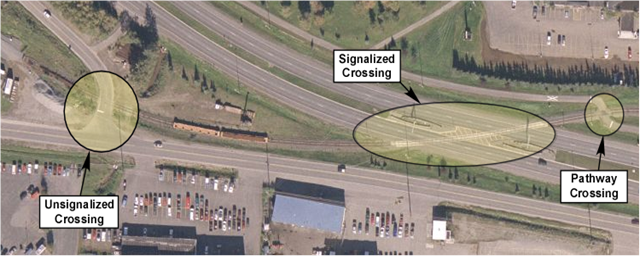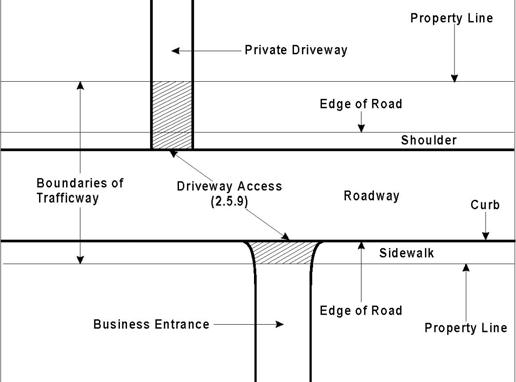

01 - Non-Junction is used for crashes where the first harmful event occurs outside an interchange area and does not occur in or related to a junction, ramp, rail grade crossing, crossover, or shared-use path or trail. This option includes crashes that occur on a parking lot way (access road) at the connection of a parking aisle. See the following diagram:
Example Parking Lot Area
(01 – Non-junction, 02 – Intersection)

(01 – Non-junction, 02 – Intersection)

02 - Intersection is used when the first harmful event occurs in an area which: (1) contains a crossing or connection of two or more roadways not classified as a driveway access, and (2) is embraced within the prolongation of the lateral curb lines or, if none, the lateral boundary lines of the roadways. Where the distance along a roadway between two areas meeting these criteria is less than 30 feet, the two areas and the roadway connecting them are considered to be parts of a single intersection.
03 - Intersection-Related means that the first harmful event: (1) occurs on an approach to or exit from an intersection, not on an entrance/exit ramp and (2) results from an activity, behavior or control related to the movement of traffic units through the intersection.
Note:
- For crashes where the first harmful event occurs in a crosswalk, use 03 -Intersection-Related.
- For Roundabouts, select 02 - Intersection when the first harmful event occurs within the area formed by the prolongation of curb or edge lines of the approach legs of the intersection, regardless of whether or not the crash was in any way related to an intersection. Use 03 - Intersection-Related if the first harmful event occurs in the central island or any directional island which serves the rotary intersection.
- on a driveway access
- or involves a road vehicle entering or leaving by way of a driveway access where at least one party involved (vehicle, pedalcyclist or pedestrian) is physically on the driveway access within the trafficway.
Examples:
- A car turning into a private residence driveway strikes a bicyclist riding on the sidewalk that crosses over the driveway access.
- A tractor trailer backing out of a business entrance onto the trafficway, while partially on the driveway access, is struck by a car on the roadway.
 Commercial Driveways |
 Residential Driveway |
05 - Entrance/Exit Ramp Related is used when the first harmful event occurs:
- On either an entrance or exit ramp roadway, or
- Off the entrance/exit roadway, but related to the use of or entry onto the ramp.


06 - Railway Grade Crossing is used when the first harmful event occurred in the area formed by the at-grade connection of a railroad bed and a roadway. Crashes occurring outside a railway grade crossing due to traffic congestion associated with a railway grade crossing are considered non-junction.

07 - Crossover-Related is used when the first harmful event occurs in a crossover or on approach to or exit from a crossover and related to the use of the crossover.
Note: A crossover is the area of the median of a divided trafficway where motor vehicles are permitted to cross the opposing lane or traffic or execute a U-turn.

Freeway Crossover Example
08 - Driveway Access Related is used when the first harmful event:
- occurs on the trafficway,
- does not occur on a 04 - Driveway Access, but
- results from an activity, behavior or control related to the movement of parties involved onto or out of a driveway.
- A vehicle attempting to turn left into a driveway from the eastbound lanes is struck broadside by another vehicle traveling in the westbound lanes,
- A vehicle that has just entered the trafficway from a driveway is struck in the rear before it can gain speed.
Note: If there is not sufficient detail available to differentiate between driveway access and driveway access related, but it is known that the vehicle was coming out of (or going into) a driveway, default to 08 - Driveway Access Related. See the following diagram:
Figure 4 from ANSI D16 7TH Edition (Driveway Access 2.3.9)


16 - Shared-Use Path or Trail is used when the first harmful event occurs at the crossing of a roadway and Shared-Use Path or Trail. At least one non-motorist (pedestrian, bicyclist, etc.) has to be physically in the shared use path or trail and the crash has to be related to the use of it. If the 16 - Shared-Use Path or Trail is within the boundaries of an 02 - Intersection, then select 16 - Shared-Use Path or Trail.
Note: A 16 - Shared-Use Path or Trail is a bikeway physically separated from motorized vehicular traffic by an open space or barrier and either within the highway right of way or an independent right of way. Shared-use paths will also be used by pedestrians, skaters, wheelchairs, joggers and other non-motorist users. A shared-use path or trail is not a sidewalk and where a shared-use path crosses another road is not a crosswalk.
17 - Acceleration/Deceleration Lane is used when the first harmful event occurs on the roadway in an interchange area on an auxiliary or speed-change lane that allows vehicles to accelerate to highway speeds before entering the through roadway or decelerate to safe speeds to negotiate a ramp without interrupting traffic flow on the through roadway exited.
18 - Through Roadway is used when the first harmful event occurs on the roadway within an interchange area but does NOT occur:
- In an intersection or related to an intersection
- On a 05 - Entrance/Exit Ramp or related to the use of a ramp
- In a 17 - Acceleration/Deceleration Lane
Examples:
- A vehicle on the 18 - Through Roadway portion of the interchange departs the roadway and overturns in the median.
- A vehicle leaves the 18 - Through Roadway portion of the interchange and strikes a vehicle parked on the shoulder.